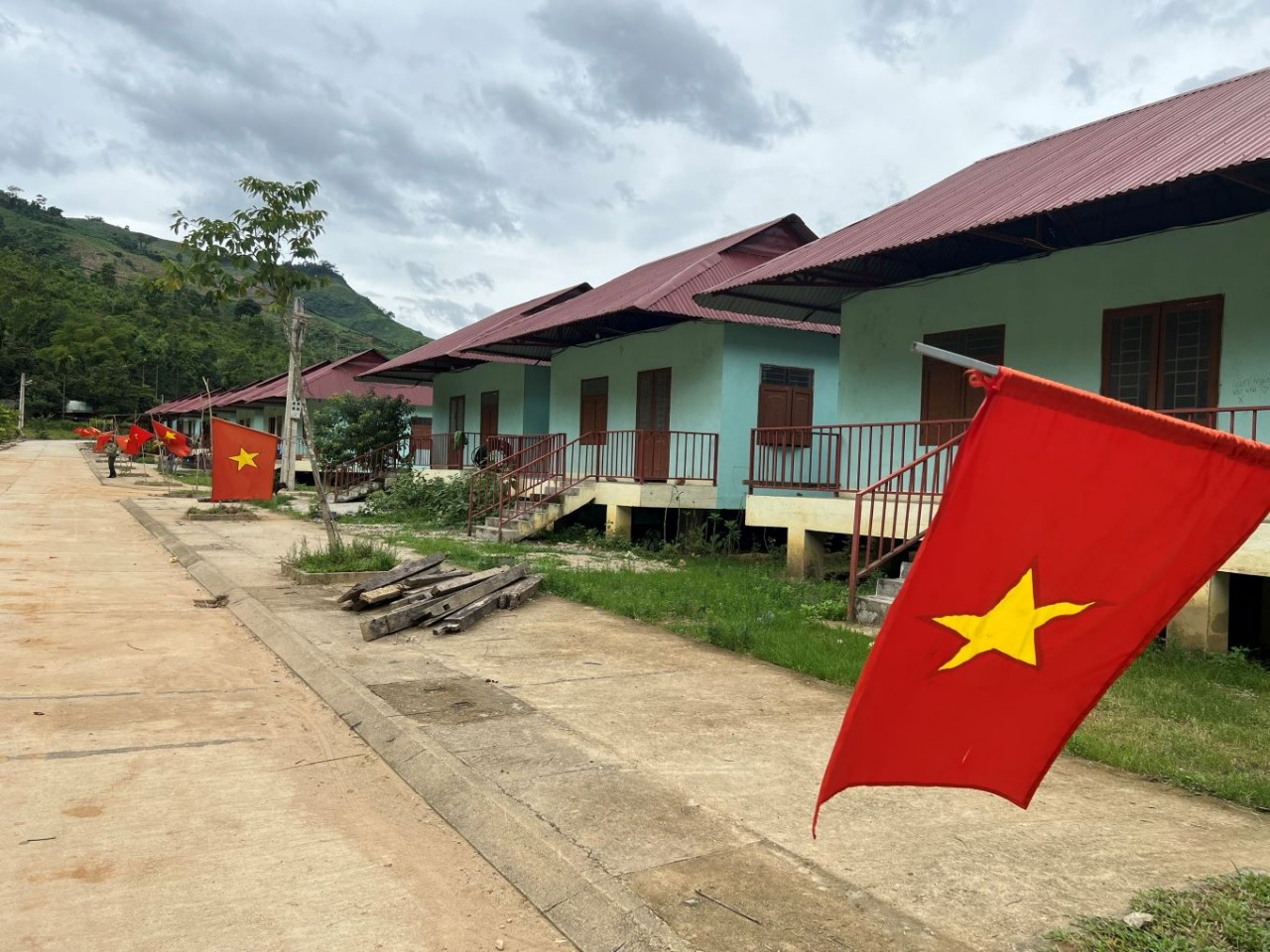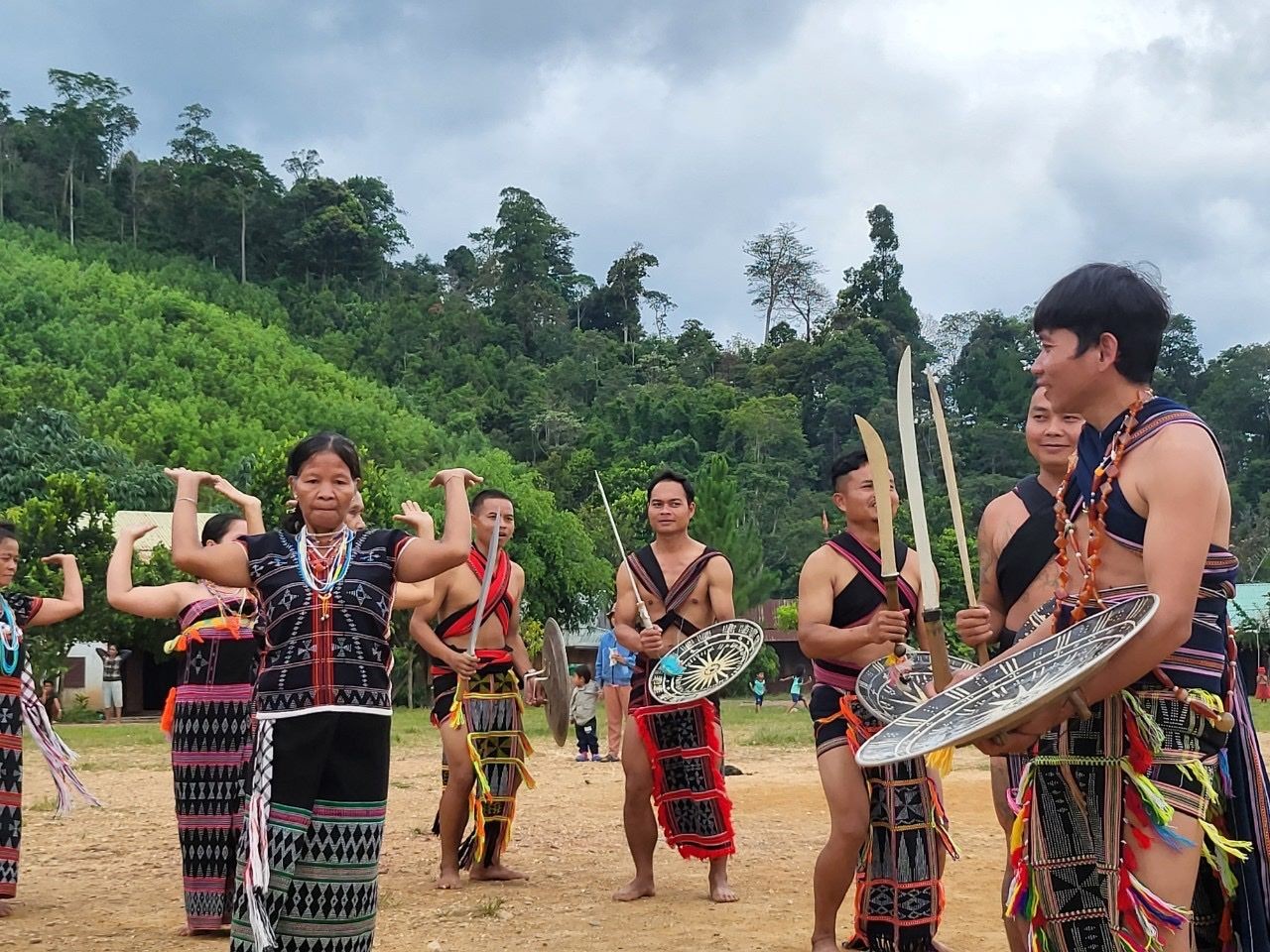
Quang Nam: New vitality from villages at high mountain
Latest
 |
| New houses in Bang La residential area, Tra Leng commute, Nam Tra My district. (Photo: Thu Uyen) |
New vitality after disaster
Our first stop is Tra Leng commune, of Nam Tra My district. In 2020, this area has seen a severe landslide, which wiped out 39 households and killed 24 people of two Bh’noong villages: Bo De and Tak Pat village.
Just a few days after the landslide, the People's Committees of Nam Tra My district and Tra Leng commute have collected opinions for a new residential area.
With the support from the local government, sponsors and benefactors, Bang La hamlet has been built just 7 km away from the old villages with safer terrain. Bang La in Bh’noong means the flat land with bamboo trees growing. Now, Bang La hamlet has 39 households from the two damaged villages.
Had us in his new 200m2 house in Bh’noong style in Bang La, Ho Van De, who has built Bo De village 22 years ago with his name in the village, has closed his grief of losing 8 people in his family in the landslide. Now, his life is no longer lonely since the house received is near the road to the new village, in the central location.
Ho Van De showed his joy when he was visited everyday by police in the commune area. They call him “Father De”. “Father De” showed the gratitude to the Party, State and authorities of Nam Tra My district and Tra Leng commune, that thanks to them he and his people can have safe and peaceful life. “Now, we don’t need to worry about hunger and survival anymore”, he said.
De often advises Bang La villagers that when having a new house and are supported with capital and plant varieties, they need to work hard to get out of poverty to have a better life than before. De and his wife are also working and earn 40-50 million VND per year.
Some Bh’noong household has lost their newly bult house worth 300 million dong like Tran Thi Lieu, also lost her husband during the landslide. But now, her life has settled. There are full appliances in her house with TV, refrigerator and even a speaker for entertainment. Lieu is also happier with a 1-year-old grandchild, who is taking her very first step.
“Now I don’t need to scare storm and rain. The kindergarten is right in front of the house. We also have a field with more than 5,000 cinnamon trees about 20 years old; 2 acacia gardens are about to be harvested. I am happy when life is settled like that,” Lieu happily shared.
When mentioning about the landslide in Bo De and Tak Pat village, lieutenant colonel Mai Xuan Sang, Head of Nam Tra My district police still sobbed. It was a difficult and stressful time with the rescue force. Because of the flood, the whole district of Nam Tra My has the electricity and the communication channel cut off. To enter Tra Leng, officers had to wade through the forest for nearly a day. They only ate rice and dried fish for the whole week in order to dig, search and move people to the safe place.
The change of life in Bang La hamlet indeed is the miracle, according to Sang. It comes from the determination and consensus from local authorities to people and businesses who joined hand to rebuild and revive a new life, make up for the loss and pain from the natural disaster.
Phan Quoc Cuong - Chairman of Tra Leng Commune People's Committee said: People affected by the landslide are supported with houses and essential infrastructure such as electricity, roads, schools, medical stations, etc. Besides, the locality has also mobilized sponsors to provide additional support for their costs. initial activities. Regarding livelihood, after resettling, people continue to cultivate in the previous land by planting cinnamon, planting areca fruit, fruit trees... Currently, every household has 1-2 labors, with average income of 40-50 million per year.
 |
| Co Tu ethnic minority people at Lang commune, Tay Giang district, Quang Nam province. (Photo: (Photo: Thu Uyen) |
Co Tu people grow herbs to escape poverty
When visiting A roh hamlet, Lang commune of Tay Giang district - a disadvantaged mountainous district of Quang Nam, we have seen the organized and disciplines lifestyle of Co Tu people living here. With the close care of the local authorities and police, Co Tu people have hardly ever engaged in thieves or social evils.
The only thing that need to be changed is to develop family economy, have to consider “poverty as a enemy, the suffering, the shame”- as told by Bh riu Po, the old villager, meritorious artisan, the one who has inspired Lang commune people to grow medicinal plants, dig fish ponds to escape poverty.
Bh riu Po graduated Thai Nguyen University of Education, then came back to hometown to work at the district’s education office, and then became Secretary, Chairman of Lang commune from 1989 to 2005. Within 16 years of working, his biggest wish to find a right economic module for people in the area, and the most important, is having a visible example so that they will believe and follow.
To make that wish come true, Bh riu Po has retired two years early to find medicinal herbs to grow, knowing that their hometown has some rare medicinal herbs like indigenous Indian Mulberry. He has experimented to find a way to grow Indian Mulberry the natural way without using fertilizer, keeping the same value as the wild plants.
In 2017, he started with 100 plants of Indian Mulberry. Many people have said he was crazy, because “how can wild plants be grown?”. However, three months later, his plants have beard fruits. Bh riu Po has expanded the field, and now has 1.3 ha of Indian Mulberry. Every year, he sells 1000 plants, which results in yearly income of 100 million VND. Besides, he also does fish farming which earn him 210 million VND per year.
Seeing the positive result of the family business, many Co Tu people from A roh hamlet and 4 other hamlets in Lang commune have come to Bh riu Po’s field to learn and follow. Tay Giang district also support people with seeds and additional subsidies to grow plants. Since growing Indian Mulberry and other medicinal plants, 65-70% household here have escaped poverty.
Bhling Mia, Secretary of the District Party Committee, Chairman of the People's Council of Tay Giang district said Tay Giang is the mountainous district, with 98% of the population are Co Tu people. Co Tu people have healthy lifestyle, with no engagement in thieves or other social evils.
With that advantage, alongside with some potential of forest, medicinal herbs and culture, the local authorities have oriented to develop tourism with a harmony between conservation and exploitation. To maximize the potential of forests that have been recognized as the national heritages, as well as some historical landmarks in the area, community-based tourism have been considered.
“The most important thing is to change the way of thinking and doing of the people here, create job to change their live and lifted poverty sustainably” Mia said.
That goal needs a lot of determination so this highest and the most sparsely populated district of Quang Nam province can really transform, like their slogan: “Tay Giang determined to build a new rural”.

















